A relay is an electrically operated switch .Many relays use an electromagnet to mechanically operating a switch, but other operating principles are also used , such as solid state relays .Relays are used where it is necessary to control a circuit by a separate low-power signal , or where several circuits must be controlled by one circuit and re-transmitted it on another circuit .Relays were used extensively in telephone exchanges and early computers to perform logical operations .
A type of relay that can handle the high power required to directly control an electric motor or other loads is called a contractor .Solid- State relays control power circuits with no moving parts , instead using a semiconductor device to perform switching. Relays with calibrated operating characteristics and sometimes multiple operating coils are used to protect electrical circuits from overload or faults; in modern electric power systems these functions are performed by digital instruments still called “protective relays “.
Safety relays are devices which generally implement safety functions. In the count of a hazard, the task of such a safety function is to use appropriate measures to reduce the existing risk to an acceptance level.
Working Principle of Relay
It works on the principle of an electromagnetic attraction. When the circuit of the relay senses the fault current, it energizes the electromagnetic field which produces the temporary magnetic field.
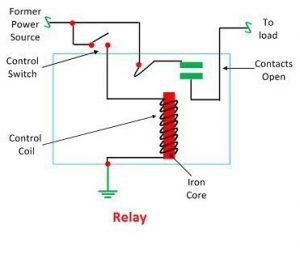 The diagram shows an inner section diagram of a relay. An iron core is surrounded by a control coil. As shown, the power source is given to the electromagnet through a control switch and through contacts to the load. When current starts flowing through the control coil, the electromagnet starts energizing and thus intensifies the magnetic field. Thus the upper contact arm starts to be attracted to the lower fixed arm and thus closes the contacts causing a short circuit for the power to the load. On the other hand, if the relay was already de-energized when the contacts were closed, then the contact move oppositely and make an open circuit.
The diagram shows an inner section diagram of a relay. An iron core is surrounded by a control coil. As shown, the power source is given to the electromagnet through a control switch and through contacts to the load. When current starts flowing through the control coil, the electromagnet starts energizing and thus intensifies the magnetic field. Thus the upper contact arm starts to be attracted to the lower fixed arm and thus closes the contacts causing a short circuit for the power to the load. On the other hand, if the relay was already de-energized when the contacts were closed, then the contact move oppositely and make an open circuit.
As soon as the coil current is off, the movable armature will be returned by a force back to its initial position. This force will be almost equal to half the strength of the magnetic force. This force is mainly provided by two factors. They are the spring and also gravity.
Relays are mainly made for two basic operations. One is low voltage application and the other is high voltage. For low voltage applications, more preference will be given to reduce the noise of the whole circuit. For high voltage applications, they are mainly designed to reduce a phenomenon called arcing.
Relay Basics
The basics for all the relays are the same. Take a look at a 4 – pin relay shown below. There are two colours shown. The green colour represents the control circuit and the red colour represents the load circuit. A small control coil is connected onto the control circuit. A switch is connected to the load. This switch is controlled by the coil in the control circuit. Now let us take the different steps that occur in a relay.
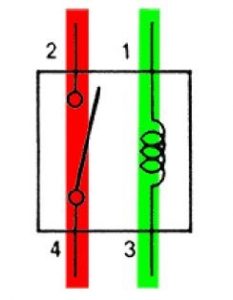
relay operation
- Energized Relay (ON)
As shown in the circuit, the current flowing through the coils represented by pins 1 and 3 causes a magnetic field to be aroused. This magnetic field causes the closing of the pins 2 and 4. Thus the switch plays an important role in the relay working. As it is a part of the load circuit, it is used to control an electrical circuit that is connected to it. Thus, when the electrical relay in energized the current flow will be through the pins 2 and 4.
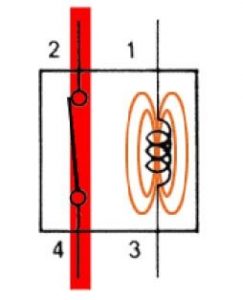
Energized Relay (ON)
- De – Energized Relay (OFF)
As soon as the current flow stops through pins 1 and 3, the relay switch opens and thus the open circuit prevents the current flow through pins 2 and 4. Thus the relay becomes de-energized and thus in off position.
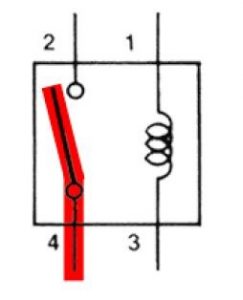
De-Energized Relay (OFF)
In simple, when a voltage is applied to pin 1, the electromagnet activates, causing a magnetic field to be developed, which goes on to close the pins 2 and 4 causing a closed circuit. When there is no voltage on pin 1, there will be no electromagnetic force and thus no magnetic field. Thus the switches remain open.
Pole and Throw
Relays have the exact working of a switch. So, the same concept is also applied. A relay is said to switch one or more poles. Each pole has contacts that can be thrown in mainly three ways. They are
- Normally Open Contact (NO) – NO contact is also called a make contact. It closes the circuit when the relay is activated. It disconnects the circuit when the relay is inactive.
- Normally Closed Contact (NC) – NC contact is also known as break contact. This is opposite to the NO contact. When the relay is activated, the circuit disconnects. When the relay is deactivated, the circuit connects.
- Change-over (CO) / Double-throw (DT) Contacts – This type of contacts are used to control two types of circuits. They are used to control a NO contact and also a NC contact with a common terminal. According to their type they are called by the names break before make and make before break
Relays can be used to control several circuits by just one signal. A relay switches one or more poles, each of whose contacts can be thrown by energizing the coil.
Relays are also named with designations like
- Single Pole Single Throw (SPST) – The SPST relay has a total of four terminals. Out of these two terminals can be connected or disconnected. The other two terminals are needed for the coil to be connected.
- Single Pole Double Throw (SPDT) – The SPDT relay has a total of five terminals. Out of these two are the coil terminals. A common terminal is also included which connects to either of two others.
- Double Pole Single Throw (DPST) – The DPST relay has a total of six terminals. These terminals are further divided into two pairs. Thus they can act as two SPST’s which are actuated by a single coil. Out of the six terminals two of them are coil terminals.
- Double Pole Double Throw (DPDT) – The DPDT relay is the biggest of all. It has mainly eight relay terminals. Out of these two rows are designed to be change over terminals. They are designed to act as two SPDT relays which are actuated by a single coil.
Construction of Relay
The relay operates both electrically and mechanically. It consists electromagnetic and sets of contacts which perform the operation of the switching. The construction of relay is mainly classified into four groups. They are the contacts, bearings, electromechanical design, terminations and housing.
Contacts – The contacts are the most important part of the relay that affects the reliability. The good contact gives limited contact resistance and reduced contact wear. The selection of the contact material depends upon the several factors like nature of the current to be interrupted, the magnitude of the current to be interrupted, frequency and voltage of operation.
Bearing – The bearing may be a single ball, multi-ball, pivot-ball and jewel bearing. The single ball bearing is used for high sensitivity and low friction. The multi-ball bearing provides low friction and greater resistance to shock.
Electromechanical design – The electromechanical design includes the design of the magnetic circuit and the mechanical attachment of core, yoke and armature. The reluctance of the magnetic path is kept minimum for making the circuit more efficient. The electromagnet is made up of soft iron, and the coil current is usually restricted to 5A and the coil voltage to 220V.
Terminations and Housing – The assembly of an armature with the magnet and the base is made with the help of spring. The spring is insulated from the armature by moulded blocks which provide dimensional stability. The fixed contacts are usually spot welded on the terminal link.
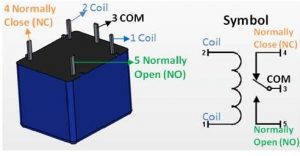
Figure : RELAY
Relay Applications
- A relay circuit is used to realize logic functions. They play a very important role in providing safety critical logic.
- Relays are used to provide time delay functions. They are used to time the delay open and delay close of contacts.
- Relays are used to control high voltage circuits with the help of low voltage signals. Similarly they are used to control high current circuits with the help of low current signals.
- They are also used as protective relays. By this function all the faults during transmission and reception can be detected and isolated.
Application of Overload Relay
Overload relay is an electro-mechanical device that is used to safeguard motors from overloads and power failures. Overload relays are installed in motors to safeguard against sudden current spikes that may damage the motor. An overload relay switch works in characteristics with current over time and is different from circuit breakers and fuses, where a sudden trip is made to turn off the motor.
The most widely used overload relay is the thermal overload relay where a bimetallic strip is used to turn off the motor. This strip is set to make contact with a contactor by bending itself with rising temperatures due to excess current flow. The contact between the strip and the contactor causes the contactor to de-energize and restricts the power to the motor, and thus turns it off.
Another type of overload motor is the electronic type which continuously watches the motor current, whereas the thermal overload relay shuts off the motor depending on the rise of temperature/heat of the strip.
All overload relays available to buy comes in different specifications, the most important of them being the current ranges and response time. Most of them are designed to automatically reset to work after the motor is turned back on.
Relay Selection
You must note some factors while selecting a particular relay. They are
- Protection – Different protections like contact protection and coil protection must be noted. Contact protection helps in reducing arcing in circuits using inductors. Coil protection helps in reducing surge voltage produced during switching.
- Look for a standard relay with all regulatory approvals.
- Switching time – Ask for high speed switching relays if you want one.
- Ratings – There are current as well as voltage ratings. The current ratings vary from a few amperes to about 3000 amperes. In case of voltage ratings, they vary from 300 Volt AC to 600 Volt AC. There are also high voltage relays of about 15,000 Volts.
- Type of contact used – Whether it is a NC or NO or closed contact.
- Select Make before Break or Break before Make contacts wisely.
- Isolation between coil circuit and contacts
Additional information:-
This is relay board with 4 SPDT Relays controlled from USB port of your computer. The main purpose of this USB relay module is to help you building projects regarding robotics and home automation (domestic). You may control different electrical devices like home lights, DC motors, pneumatic cylinders, lasers and so on. Each such board requires one USB port. The more USB ports you have the more such relay units you may connect and control. . The relay module outputs are controlled by FT245RL. It has 8 bit data output register (this device use only 4 of them). The USB relay card cannot be controlled directly via COM port -you need to download our DRM Software to control the device. The USB relay unit cannot work without PC. Only one such device can be supplied from single USB port. If you want to supply many such devices you need USB HUB with extra power supply.
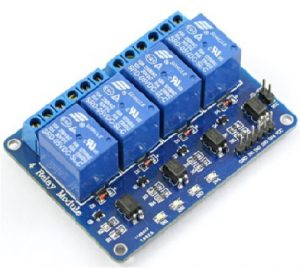
Figure : Four Channel Relay











